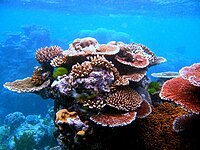
Photo from wikipedia
Abstract The symbiotic relationship between dinoflagellate algae in the family Symbiodiniaceae and scleractinian corals forms the base of the tropical reef ecosystem. In scleractinian corals, recruits acquire symbionts either “vertically”… Click to show full abstract
Abstract The symbiotic relationship between dinoflagellate algae in the family Symbiodiniaceae and scleractinian corals forms the base of the tropical reef ecosystem. In scleractinian corals, recruits acquire symbionts either “vertically” from the maternal colony or initially lack symbionts and acquire them “horizontally” from the environment. Regardless of the mode of acquisition, coral species and individual colonies harbor only a subset of the highly diverse complex of species/taxa within the Symbiodiniaceae. This suggests a genetic basis for specificity, but local environmental conditions and/or symbiont availability may also play a role in determining which symbionts within the Symbiodiniaceae are initially taken up by the host. To address the relative importance of genetic and environmental drivers of symbiont uptake/establishment, we examined the acquisition of these dinoflagellate symbionts in one to three‐month‐old recruits of Orbicella faveolata to compare symbiont types present in recruits to those of parental populations versus co‐occurring adults in their destination reef. Variation in chloroplast 23S ribosomal DNA and in three polymorphic microsatellite loci was examined. We found that, in general, symbiont communities within adult colonies differed between reefs, suggesting that endemism is common among symbiont populations of O. faveolata on a local scale. Among recruits, initial symbiont acquisition was selective. O. faveolata recruits only acquired a subset of locally available symbionts, and these generally did not reflect symbiont populations in adults at either the parental or the outplant reef. Instead, symbiont communities within new recruits at a given outplant site and region tended to be similar to each other, regardless of parental source population. These results suggest temporal variation in the local symbiont source pool, although other possible drivers behind the distinct difference between symbionts within O. faveolata adults and new generations of recruits may include different ontogenetic requirements and/or reduced host selectivity in early ontogeny.
Journal Title: Ecology and Evolution
Year Published: 2022
Link to full text (if available)
Share on Social Media: Sign Up to like & get
recommendations!